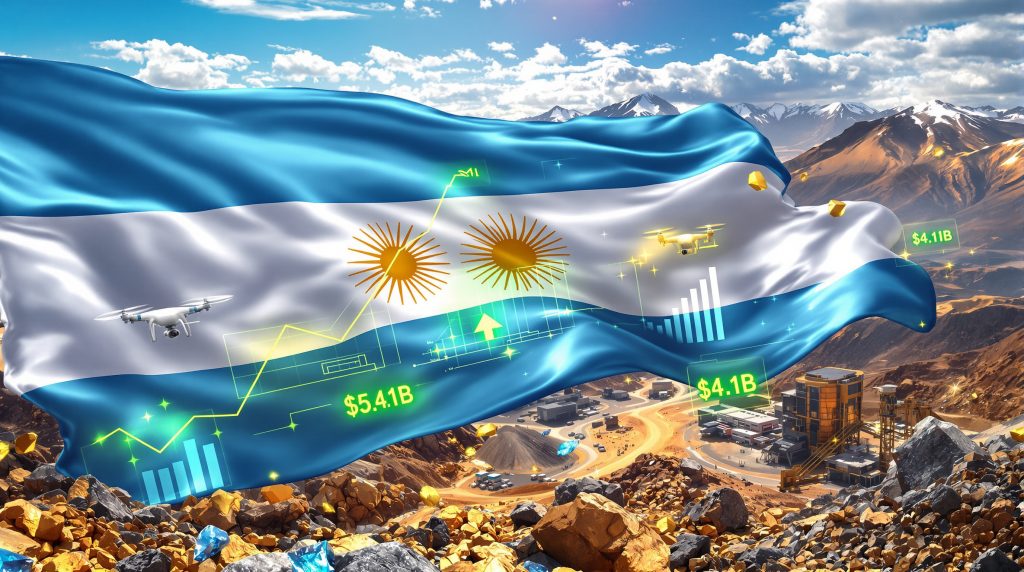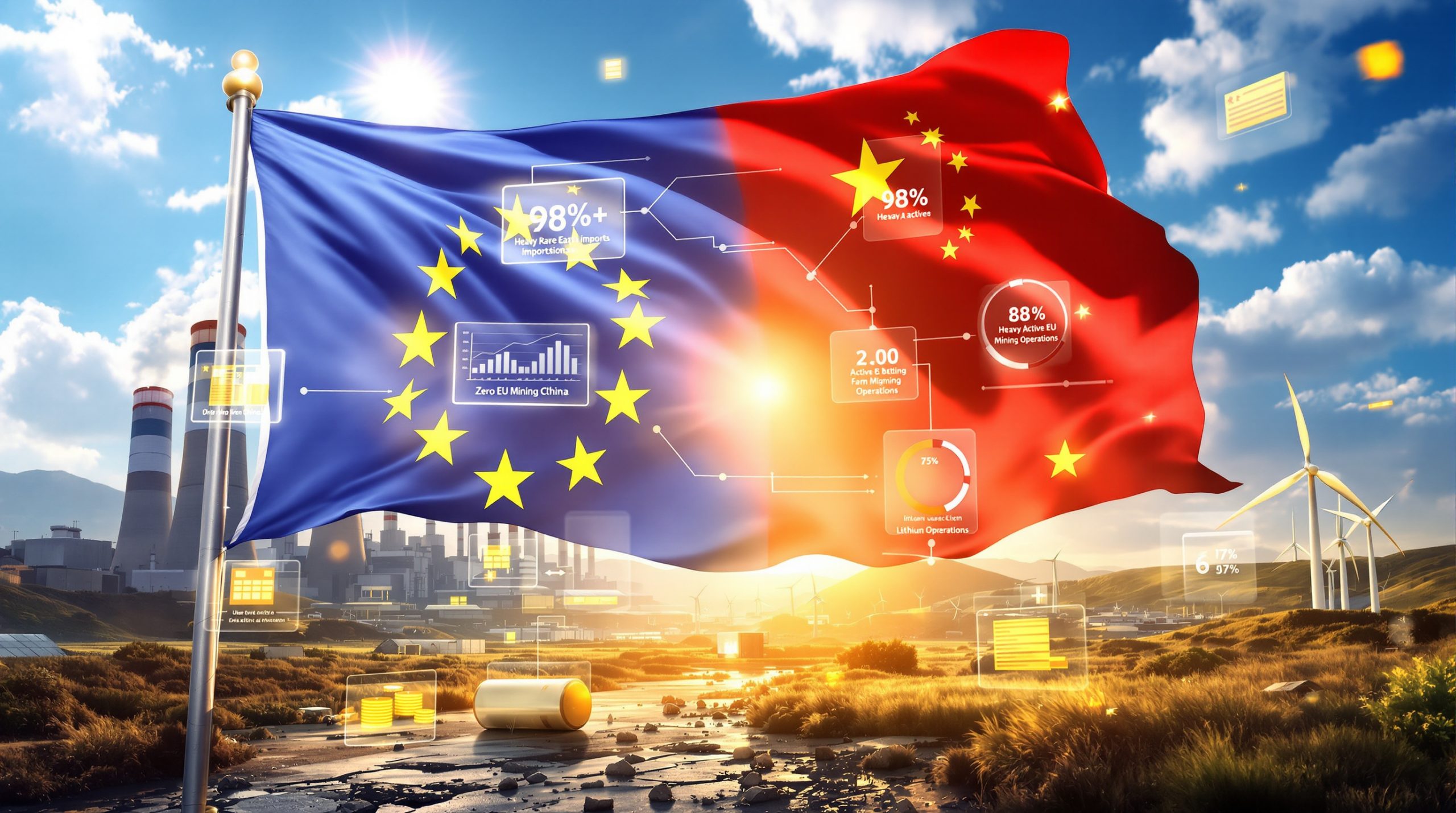The Strategic Transformation of Argentina's Cuyo Mining Region
Argentina's Cuyo region stands at the forefront of a mining revolution that extends far beyond traditional extraction methods. The annual Argentina Mining Cuyo 2025 conference, scheduled for October 29-31 in Mendoza, represents a convergence point where government policy, technological innovation, and international investment intersect to reshape Latin America's mining landscape.
The Mendoza-based event has evolved into something far more significant than a standard industry gathering. It serves as a strategic platform where major mining operations, technology providers, government officials, and international investors collaborate to define the future direction of Argentine mining development.
Cuyo Region's Geological and Strategic Advantages
The Cuyo region's positioning as Argentina's fastest-growing mining corridor stems from unique geographical and geological factors that distinguish it from traditional mining provinces. Unlike coastal mining operations, Cuyo offers proximity to Pacific export routes while maintaining significantly lower operational costs.
Regional Mining Infrastructure Overview:
- Active Operations: Multiple large-scale projects currently in production
- Primary Commodities: Copper, gold, and lithium dominating extraction activities
- Export Logistics: Direct access to Asian markets via Chilean port facilities
- Expansion Potential: Significant unexplored geological formations awaiting development
The region's geological advantages position it strategically for companies seeking to capitalize on global electrification trends and energy transition demands. Furthermore, the area's copper price predictions indicate substantial upside potential. Copper deposits in particular offer higher grade concentrations compared to many global competitors, while established processing infrastructure provides immediate operational capabilities.
Government Policy Alignment Creates Investment Certainty
The convergence of federal and provincial mining policies represents unprecedented governmental coordination in Argentina's mining sector. Luis Lucero, serving as National Secretary of Mining, has worked alongside Governor Alfredo Cornejo of Mendoza to create regulatory harmony that addresses historical fragmentation issues previously deterring international capital.
This policy alignment encompasses several critical areas that directly impact investment decisions:
Federal-Provincial Policy Coordination:
- Streamlined environmental permitting processes reducing bureaucratic delays
- Enhanced tax incentive structures specifically designed for sustainable operations
- Simplified foreign investment approval mechanisms
- Coordinated infrastructure development programs supporting mining logistics
The participation of Minister Jimena Latorre (Energy and Environment) and Mayor Ulpiano Suárez of Mendoza signals comprehensive governmental support extending from federal to municipal levels. This multi-tier coordination addresses community relations challenges that have historically complicated project development across Latin America.
Director Jerónimo Shantal of Mendoza's Mining Department will lead discussions on post-election political landscape impacts. These discussions provide direct insight into policy consistency expectations that concern international investors evaluating long-term project viability.
Technological Innovation Revolutionises Mining Operations
The integration of advanced technologies represents a fundamental shift in how mining companies approach exploration, extraction, and operational monitoring in the Cuyo region. Companies like HIKO, described as an innovative startup, are demonstrating comprehensive technological solutions that create operational intelligence previously impossible to achieve cost-effectively.
Advanced Sensor Technology Applications
HIKO's live drone demonstrations showcase integration of multiple sensor types:
- RGB sensors for high-resolution visual mapping
- Multispectral sensors for mineral identification and vegetation analysis
- Thermal sensors for equipment monitoring and safety applications
- LiDAR sensors for precise topographical mapping and volume calculations
This technological integration represents more than incremental improvement. Consequently, it fundamentally changes how mining operations conduct preliminary surveys, monitor environmental impact, and maintain equipment efficiency across remote locations typical of Cuyo region operations. The implementation of AI in mining operations further enhances these capabilities.
Digital Transformation Through HASU360 Framework
The consulting firm HASU, with Partner Manager Blanca Chávez leading their initiative, introduces a comprehensive digital transformation approach through their HASU360 program. This framework encompasses six critical development pillars:
- Innovation Integration: Technology adoption across complete operational spectrum
- Management Optimisation: Data-driven decision-making protocols and systems
- Human Capital Development: Workforce transformation and skills enhancement initiatives
- Client Relationship Enhancement: Supply chain transparency and communication improvements
- Sustainability Implementation: Environmental impact minimisation through technology
- Compliance Automation: Regulatory adherence through automated digital systems
This holistic approach addresses the reality that successful mining operations require integration across multiple organisational dimensions rather than isolated technological implementations.
Commodity Focus Drives Regional Investment Appeal
What Makes Copper the Electrification Metal Opportunity?
Argentina's copper reserves position the country advantageously within global electrification trends. The Cuyo region's copper deposits offer several competitive advantages that distinguish them from international alternatives:
Cuyo Copper Advantages:
- Higher copper concentrations compared to many established global mining regions
- Existing processing infrastructure reducing initial capital requirements
- Established refining capabilities supporting immediate production scaling
- Direct logistics access to Asian markets through Chilean export channels
- Significant unexplored geological formations indicating long-term expansion potential
The global shift toward electric vehicles, renewable energy infrastructure, and electrical grid modernisation creates sustained demand projections that favour regions capable of reliable copper production at competitive costs.
Gold Mining: Traditional Value in Modern Context
While copper attracts electrification-focused investment, gold mining provides portfolio stability and immediate revenue generation capabilities. Recent gold price analysis shows continued strength in precious metals markets. Cuyo's gold operations benefit from mature extraction systems, established trading relationships, and proven reserve bases confirmed through geological surveys.
Gold mining in the region leverages modern extraction methods that improve yield efficiency while maintaining environmental compliance standards increasingly demanded by international markets and regulatory frameworks.
Lithium Exploration: Strategic Metal Diversification
Although Argentina's lithium production traditionally concentrates in northern provinces, Cuyo region exploration reveals promising deposits that could diversify the country's lithium production geography. For instance, comprehensive lithium brine market insights reveal significant expansion opportunities. This geographic diversification reduces operational risks while potentially lowering transportation costs to processing facilities and export terminals.
Safety and Environmental Innovation Leadership
Transportation Safety in Remote Operations
SGL Transporte, specialising in mining logistics particularly for lithium industry supply transport in Northwestern Argentina, demonstrates how companies address unique challenges associated with remote site operations. Their safety awareness campaigns focus specifically on route risk assessment and emergency response protocols.
Comprehensive Safety Framework:
- Route risk assessment mapping comprehensive hazard identification for mining transport corridors
- Emergency response training with specialised protocols for remote location incidents
- Equipment standardisation ensuring uniform safety technology across transport networks
- Community integration coordinating with local emergency services and providing training
The geographic isolation characteristic of many Cuyo region mining operations makes these safety protocols critically important for both regulatory compliance and operational continuity.
Environmental Compliance Through Technology
RESTEC, described as an environmental solutions firm integrating with Argentina's National Emergency Network, showcases how modern mining operations proactively address environmental concerns through technological innovation and standardised response protocols.
Their NFPA 472 compliance demonstrations represent industry-leading environmental protection standards. NFPA 472 establishes competency standards for hazardous materials response technicians, indicating serious commitment to environmental risk management and emergency response capabilities.
The integration of environmental monitoring technology with community engagement creates transparent accountability systems that benefit all stakeholders involved in mining operations.
Post-Election Political Landscape Analysis
The conference panel titled "Elections Have Passed, and Now What?" addresses critical investor concerns about political continuity affecting mining operations. This discussion becomes particularly relevant given Argentina's history of policy shifts impacting foreign investment and mining sector regulations.
Political Risk Assessment Factors:
- Regulatory Continuity: Policy framework stability across political transitions
- Tax Structure Predictability: Long-term fiscal planning certainty for project development
- Infrastructure Investment Commitment: Government support for mining-related infrastructure development
- International Relations Impact: Trade relationship effects on mining export capabilities
Director Jerónimo Shantal's participation provides direct governmental insight into policy consistency expectations. However, this addresses investor concerns about regulatory stability that affect long-term project planning and capital allocation decisions.
Investment Opportunities Beyond Direct Mining
Supply Chain Integration Prospects
The conference reveals significant opportunities for companies seeking mining sector exposure through supply chain participation rather than direct mining operations. These opportunities span multiple specialised areas:
Logistics and Transportation:
- Transportation solution providers for remote mining locations
- Storage and warehousing facilities for mining equipment and materials
- Specialised transport services for hazardous materials and precious metals
Technology Integration Services:
- Software development for mining-specific applications
- Hardware system integration for remote monitoring and control
- Communication systems for isolated mining operations
- Predictive maintenance technology implementation
Environmental and Compliance Services:
- Environmental impact assessment and monitoring services
- Regulatory compliance consulting and implementation
- Remediation specialists for post-mining environmental restoration
- Community relations and stakeholder engagement consulting
International Partnership Development
The networking component facilitates partnerships between Argentine operations and international technology providers, creating mutual growth opportunities across several partnership categories:
Technology Transfer Arrangements:
- Advanced equipment sharing and adaptation for local conditions
- Process optimisation techniques developed in other mining regions
- Training and knowledge transfer programmes for local workforce development
Financial Collaboration Structures:
- Joint venture arrangements combining local knowledge with international capital
- Equipment financing solutions tailored to mining industry requirements
- Risk-sharing mechanisms for exploration and development projects
Sustainability as Competitive Advantage
Community Engagement Innovation
The "Sustainability Commitment Board" initiative demonstrates how modern mining operations prioritise transparent community relationship building. This participatory approach directly addresses historical tensions between mining companies and local populations that have complicated project development across Latin America.
The initiative creates platforms for direct stakeholder engagement, allowing community members to participate actively in environmental monitoring and economic benefit evaluation. Consequently, this transparency builds trust while providing mining companies with valuable local knowledge and community support.
Sustainability Framework Components:
- Real-time environmental monitoring systems providing continuous ecosystem impact assessment
- Community participation platforms enabling direct stakeholder engagement and feedback
- Economic benefit sharing programmes integrating local development initiatives
- Long-term restoration planning for post-operation environmental recovery
Environmental Technology Integration
Modern mining operations in the Cuyo region increasingly integrate environmental monitoring technology with community engagement initiatives. Furthermore, this creates accountability systems that serve multiple stakeholder interests simultaneously.
This integration represents a significant evolution from traditional mining approaches, where environmental and community considerations often remained separate from operational decision-making processes.
Distinguishing Features of Argentina Mining Cuyo
Regional Specialisation Creates Focused Value
Unlike global mining conferences addressing broad industry themes, Argentina Mining Cuyo 2025 provides concentrated expertise specifically relevant to Cuyo region opportunities and challenges. This regional focus allows for detailed discussion of local geological conditions, specific regulatory frameworks, and targeted investment opportunities.
Practical Implementation Over Theoretical Discussion
The conference emphasises hands-on demonstrations, live technology showcases, and direct government participation rather than abstract industry analysis. HIKO's drone demonstrations, RESTEC's emergency response training, and SGL Transporte's safety protocols provide actionable intelligence for operational implementation.
Multi-Stakeholder Integration
The combination of mining companies, technology providers, government officials, and community representatives creates comprehensive understanding of the complete mining ecosystem. This integration addresses the reality that successful mining projects require coordination across multiple stakeholder groups with different objectives and concerns.
Regional Economic Impact and Future Projections
The transformation occurring in Argentina's Cuyo region extends beyond individual mining projects to encompass broader economic development patterns. The region's strategic positioning between mineral-rich geological formations and Pacific export routes creates opportunities for sustained economic growth based on mining sector expansion.
Economic Development Indicators:
- Employment generation through direct mining operations and supporting industries
- Infrastructure development stimulated by mining logistics requirements
- Technology sector growth driven by mining industry demand for specialised services
- Export revenue contribution to national and regional economic stability
The integration of advanced technologies, supportive government policies, and international investment interest creates conditions for sustained growth. In addition, this extends beyond traditional boom-and-bust cycles historically associated with mining regions.
Technological Integration and Workforce Development
The emphasis on technological innovation requires corresponding workforce development initiatives that prepare local populations for evolving mining industry requirements. The HASU360 framework specifically addresses human capital development as one of its six core pillars.
Workforce Transformation Elements:
- Technical training programmes for advanced equipment operation and maintenance
- Safety protocol education for remote and hazardous environment operations
- Environmental monitoring and compliance training programmes
- Management and leadership development for locally-based personnel
This workforce development approach creates sustainable employment opportunities while building local capacity to support long-term mining sector growth.
International Market Integration
Argentina's Cuyo region mining development occurs within the context of global supply chain integration for critical minerals and metals. The region's copper, gold, and lithium production contributes to international markets experiencing significant demand growth driven by electrification and energy transition initiatives.
Global Market Integration Factors:
- Supply chain reliability for international manufacturing operations
- Quality standards meeting international specifications for metal purity and consistency
- Logistics efficiency connecting Argentine production to global consumption centres
- Regulatory compliance with international environmental and safety standards
The ability to meet these international integration requirements determines long-term success prospects for Cuyo region mining operations seeking sustainable market participation. Moreover, successful gold and copper exploration initiatives support this regional development.
Companies interested in exploring these opportunities can find comprehensive information through the Argentina Mining portal, which provides detailed insights into upcoming projects and initiatives. Additionally, professionals seeking networking opportunities can connect through various mining industry events that facilitate strategic partnerships.
Argentina Mining Cuyo 2025 represents far more than an industry conference. It symbolises Argentina's strategic emergence as a critical supplier for global electrification and energy transition initiatives. The convergence of favourable geology, supportive government policies, technological innovation, and international investment interest creates unprecedented opportunities for industry participants.
The Cuyo region's advantages, combined with Argentina's broader mineral endowments, position the country to become an essential component of global supply chains supporting renewable energy infrastructure. Furthermore, these developments support electric vehicle production and technological advancement requiring critical minerals and metals.
Companies and investors participating in Argentina Mining Cuyo 2025 gain direct access to this transformation as it develops, providing strategic positioning within one of South America's most promising mining regions.
Want to Capitalise on Emerging Mining Opportunities?
Discovery Alert's proprietary Discovery IQ model delivers instant notifications when significant ASX mineral discoveries are announced, helping investors identify actionable opportunities in the rapidly evolving mining sector before the broader market responds. Understand why historic discoveries can generate substantial returns and begin your 30-day free trial today to position yourself ahead of the market.




